Climatic Indicators and Their Variation Trends as Conditions for Forest Flammability Hazard in the South of Tyumen Oblast
Abstract
1. Introduction
2. Materials and Methods
2.1. Data Sets and Basic Statistical Methods
- Monthly average daily air temperatures (in °C, code “t”, 34 models in both scenarios);
- Monthly average maximum daily air temperatures (in °C, code “tx”, 27 models in both scenarios);
- Monthly average values of daily snow precipitation (in mm, code “prsn”, 29 models in both scenarios);
- Number of consecutive dry days by year (in days, code “cdd”, 31 models for SSP2-4.5 scenario and 32 models for SSP5-8.5 scenario);
- Number of days with temperatures above 35 °C by month (in days, code “tx35”, 27 models in both scenarios).
2.2. Verification of CMIP6 Models
3. Results
3.1. Climate Indicators, Their Trends, and Correlation with Wildfires
3.2. Forecast Assessments of Climate Indicators by Models
4. Discussion and Conclusions
Author Contributions
Funding
Data Availability Statement
Acknowledgments
Conflicts of Interest
Appendix A
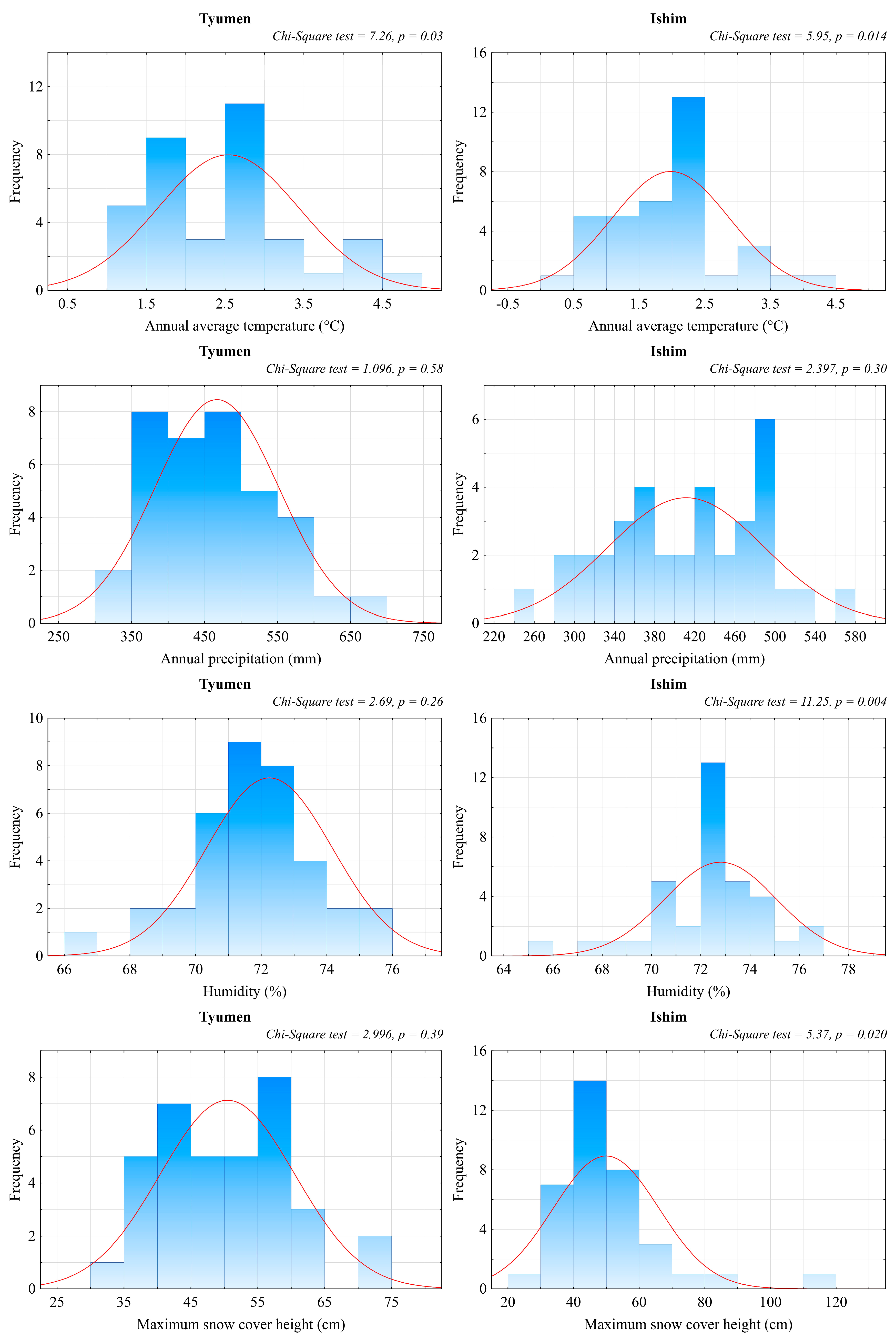
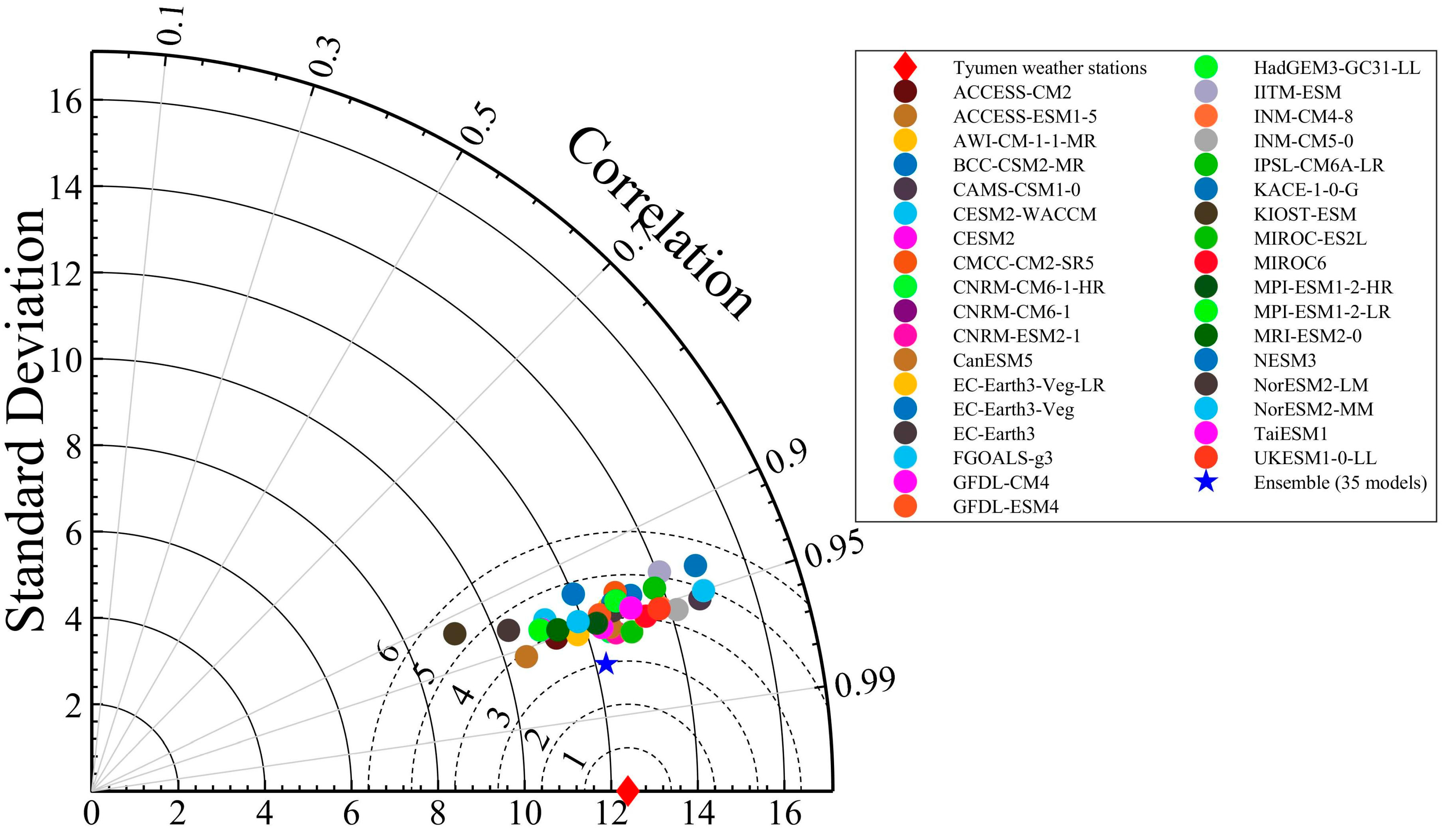
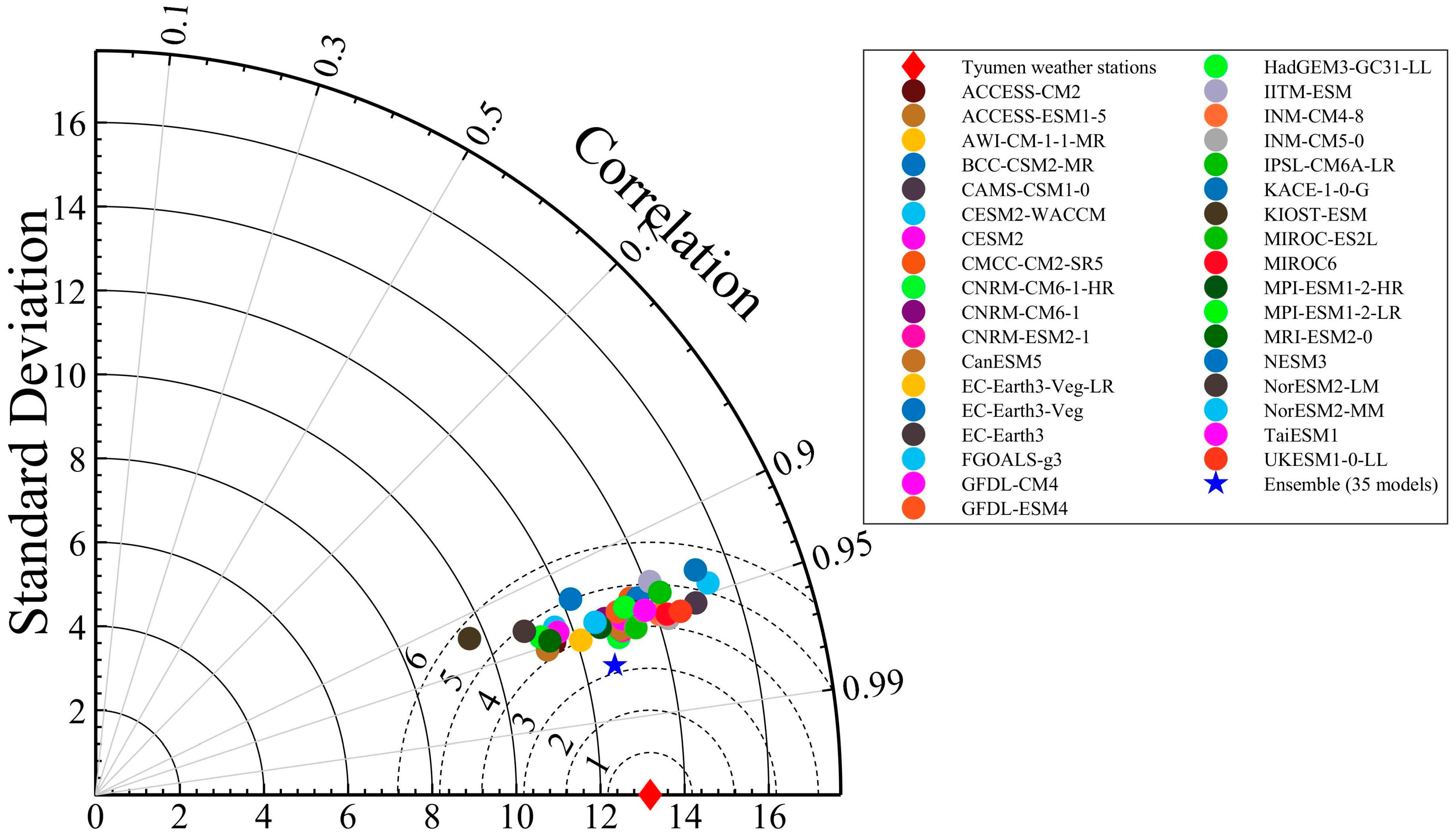
References
- IPCC. Climate Change 2021: The Physical Science Basis. Contribution of Working Group I to the Sixth Assessment Report of the Intergovernmental Panel on Climate Change; Masson-Delmotte, V., Zhai, P., Pirani, A., Connors, S.L., Péan, C., Berger, S., Caud, N., Chen, Y., Goldfarb, L., Gomis, M.I., et al., Eds.; Cambridge University Press: New York, NY, USA, 2021. [Google Scholar]
- Noskova, E.V.; Vakhnina, I.L. Analysis of modern spatio-temporal changes in air temperature in the Trans-Baikal Territory. Geogr. Bull. 2023, 1, 116–126. [Google Scholar] [CrossRef]
- Yasyukevich, V.; Govorkova, V. (Eds.) The Second Assessment Report of Roshydromet on Climate Change and Its Consequences on the Territory of the Russian Federation; Roshydromet: Moscow, Russia, 2014; Available online: https://cc.voeikovmgo.ru/images/dokumenty/2016/od2/od2full.pdf (accessed on 8 April 2024). (In Russian)
- IPCC. Climate Change 2023: Synthesis Report. Contribution of Working Groups I, II and III to the Sixth Assessment Report of the Intergovernmental Panel on Climate Change; Lee, H., Romero, J., Eds.; IPCC: Geneva, Switzerland, 2023; p. 184. [Google Scholar] [CrossRef]
- Shaidyldaeva, N.M.; Usubaliev, R.A.; Mandychev, A.N. Climate change on the water content of the Chichkan and Ba-la-Chychkan rivers of the Ketmen-Tyube basin. Sci. New Technol. Innov. Kyrg. 2022, 3, 87–92. [Google Scholar] [CrossRef]
- Zhaparkulova, E.D.; Bazhanova, L.V.; Kalieva, K.E.; Nabiollina, M.S. Trend of climate change at the present stage, forecast for the period up to 2050 and its impact on the water content of rivers fed by glaciers and snow (using the example of the trans-boundary Kurkureu-Suu river, Talas basin). Hydrometeorol. Ecol. 2019, 4, 70–83. Available online: https://cyberleninka.ru/article/n/tendentsiya-izmeneniya-klimata-na-sovremennom-etape-prognoz-na-period-do-2050-g-i-ego-vliyanie-na-vodnost-rek-lednikovo-snegovogo/viewer (accessed on 8 April 2024). (In Russian).
- Semenova, A.A.; Goncharov, A.V. The influence of climate change on the water content and hydrochemical regime of the Pakhra River in winter. Problems of ecology of the Volga basin. In Proceedings of the 7th All-Russian Scientific Conference, Nizhny Novgorod, Russia, 27–29 November 2022; Volume V, p. 49. Available online: https://elibrary.ru/download/elibrary_53745862_69746072.pdf (accessed on 8 April 2024). (In Russian).
- Saipov, B.S.; Beyshekeev, K.K.; Kalybek, U.M. Climate change and its impact on river water content. News Univ. 2015, 1, 13–14. Available online: https://elibrary.ru/download/elibrary_23931918_76703164.pdf (accessed on 1 December 2024). (In Russian).
- Kuznetsova, V.; Kuznetsova, E.; Kushanova, A. Geographic information mapping of flood zones for sustainable development and urban landscape planning. In Proceedings of the International Multidisciplinary Scientific GeoConference SGEM 2018, Albena, Bulgaria, 30 June–9 July 2018; pp. 393–400. [Google Scholar] [CrossRef]
- Wurihan, B.; Bayarsaikhan, S.; Yuhai, B.; Siqin, T.; Hugejiletu, J.; Xueliang, Y. Spatiotemporal variations of vegetation change and its response to climate change in Mongolia during 1982–2015. Nat. Inn. Asia 2022, 2–3, 37–51. (In Russian) [Google Scholar] [CrossRef]
- Lysenko, S.A. Climate-related changes in the bioproductivity of terrestrial ecosystems in Belarus. Explor. Earth Space 2019, 6, 77–88. Available online: https://elibrary.ru/download/elibrary_41525080_79297311.pdf (accessed on 8 April 2024). (In Russian).
- Bogatov, V.V.; Baklanov, P.Y.; Lozovskaya, S.A.; Shtets, M.B. Climate change and health in the Russian Far East. Vestn. Far East Branch Russ. Acad. Sci. 2021, 1, 5–21. [Google Scholar] [CrossRef]
- Barinova, G.M.; Krasnov, E.V.; Gaeva, D.V.; Romanchuk, A.Y.; Ushakova, L.O. The spread of tick-borne infections in conditions of climate change and the problem of adaptation to them by the population of the Kaliningrad region. Probl. Reg. Ecol. 2022, 4, 63–67. (In Russian) [Google Scholar] [CrossRef]
- Povarnitsyna, A.V.; Savin, M.I. Impact of climate change on global agriculture. Trends Dev. Sci. Educ. 2022, 84, 152–157. (In Russian) [Google Scholar] [CrossRef]
- Galkin, D.G. Directions for adaptation of agriculture to the consequences of global climate change. Vestn. Plekhanov Russ. Univ. Econ. 2021, 18, 13–20. (In Russian) [Google Scholar] [CrossRef]
- Kireycheva, L.V.; Glazunova, I.V. Development and placement of agricultural reclamation in changing climatic conditions. Nat. Manag. 2017, 4, 80–87. (In Russian) [Google Scholar] [CrossRef]
- Valentini, R. The global agricultural system and climate change: Challenges and opportunities for the Russian Federation. Financ. Theory Pract. 2017, 21, 70–79. (In Russian) [Google Scholar] [CrossRef]
- Chugunkova, A.V. Modeling of logging industry dynamics under the global climate change: The evidence from Siberian regions. J. Sib. Fed. Univ. Humanit. Soc. Sci. 2020, 13, 1870–1879. [Google Scholar] [CrossRef]
- Neverov, A.V.; Ravino, A.V.; Malashevich, D.G.; Yushkevich, N.T. Climate-oriented strategy for sustainable development of forestry: General content and problems of formation. Proc. BSTU Ser. 5 Econ. Manag. 2018, 1, 28–33. Available online: https://elar.urfu.ru/bitstream/10995/65024/1/978-5-8295-0567-7_2018-072.pdf (accessed on 8 April 2024). (In Russian).
- Stepanova, Y.N.; Shcherbin, A.O. Stimulating sustainable development of the forest ecosystem in the fight against climate change. Curr. Dir. Sci. Res. XXI Century Theory Pract. 2023, 11, 94–106. (In Russian) [Google Scholar] [CrossRef]
- Khlopov, O.A. Global warming and climate change as real theats to sustanable development. Colloq.-J. 2020, 63, 30–34. [Google Scholar] [CrossRef]
- Degtyarev, K.S. Geographical basis of renewable energy. Environ. Energy Sci. 2021, 3, 25–42. (In Russian) [Google Scholar] [CrossRef]
- Tsvetkov, P.A. Essay on the history of Russian forest pyrology. Sib. Lesn. Zurnal (Sib. J. For. Sci.) 2015, 5, 3–25. (In Russian) [Google Scholar] [CrossRef]
- Federal Law of 22 December 2020 N 454-FZ “On Amendments to Certain Legislative Acts of the Russian Federation in Terms of Improving Activities in the Field of Fire Safety”. Available online: https://rg.ru/documents/2020/12/28/bezopasnost-dok.html (accessed on 8 April 2024). (In Russian).
- Flannigan, M.; Cantin, A.S.; de Groot, W.J.; Wotton, M.; Newbery, A.; Gowman, L.M. Global wildland fire season severity in the 21st century. For. Ecol. Manag. 2013, 294, 54–61. [Google Scholar] [CrossRef]
- Cunningham, C.X.; Williamson, G.J.; Bowman, D.M.J.S. Increasing frequency and intensity of the most extreme wildfires on Earth. Nat. Ecol. Evol. 2024, 8, 1420–1425. [Google Scholar] [CrossRef]
- Parisien, M.A.; Barber, Q.E.; Bourbonnais, M.L.; Daniels, L.D.; Flannigan, M.D.; Gray, R.W.; Hoffman, K.M.; Jain, P.; Stephens, S.L.; Taylor, S.W.; et al. Abrupt, climate-induced increase in wildfires in British Columbia since the mid-2000s. Commun. Earth Environ. 2023, 4, 309. [Google Scholar] [CrossRef]
- Silveira, M.V.F.; Silva-Junior, C.H.L.; Anderson, L.O.; Aragão, L.E.O. Amazon fires in the 21st century: The year of 2020 in evidence. Glob. Ecol. Biogeogr. 2022, 31, 2026–2040. [Google Scholar] [CrossRef]
- As Wildfires Increase, Integrated Strategies for Forests, Climate and Sustainability Are Ever More Urgent. Available online: https://www.un.org/en/un-chronicle/wildfires-increase-integrated-strategies-forests-climate-and-sustainability-are-ever-0 (accessed on 1 December 2024).
- Shao, Y.; Fan, G.; Feng, Z.; Sun, L.; Yang, X.; Ma, T.; Li, X.; Fu, H.; Wang, A. Prediction of forest fire occurrence in China under climate change scenarios. J. For. Res. 2023, 34, 1217–1228. [Google Scholar] [CrossRef]
- Ten Countries with the Largest Forest Area in 2021. Available online: https://www.statista.com/statistics/238893/ten-countries-with-most-forest-area/ (accessed on 8 April 2024).
- Shojaeizadeh, K.; Ahmadi, M.; Dadashi-Roudbari, A. Contribution of biophysical and climate variables to the spatial distribution of wildfires in Iran. J. For. Res. 2023, 34, 1763–1775. [Google Scholar] [CrossRef]
- Bartalev, S.A. Large-scale changes in Russian forests in the 21st century according to satellite observations (IKI RAS, Moscow, Russia). In Proceedings of the 18th All-Russian Open Conference “Modern Problems of Remote Sensing of the Earth from space”: Electronic Collection of Conference Materials, Moscow, Russia, 16–20 November 2020; Available online: http://conf.rse.geosmis.ru/files/pdf/18/8465_Bartalev_YSS_2020_Eng.pdf (accessed on 8 April 2024).
- Kattsova, V.M. (Ed.) Third Assessment Report on Climate Change and Its Consequences on the Territory of the Russian Federation; High technology; Roshydromet: St. Petersburg, Russia, 2022; p. 126. Available online: https://www.meteorf.gov.ru/upload/pdf_download/compressed.pdf (accessed on 8 April 2024). (In Russian)
- Zamolodchikov, D.; Shmatkov, N. Forests of Russia and climate change: Can we preserve our forests against a new threat? Sustain. For. Manag. 2011, 4, 12–14. Available online: https://www.elibrary.ru/download/elibrary_22517666_75467202.pdf (accessed on 1 December 2024). (In Russian).
- Tarko, A. Analysis of forest fires in the world and their relationship with the global carbon dioxide cycle. Nor. J. Dev. Int. Sci. 2020, 50, 34–44. Available online: https://www.elibrary.ru/download/elibrary_44319432_57212045.pdf (accessed on 1 December 2024). (In Russian).
- Sherstyukov, B.G. Forest fires in Russia in a changing climate. Proc. All-Russ. Sci. Res. Inst. Hydrometeorol. Inf.-World Data Cent. 2021, 188, 30–40. Available online: https://www.elibrary.ru/download/elibrary_48549663_90620095.pdf (accessed on 1 December 2024). (In Russian).
- Kopysov, S.G.; Eliseev, A.O. Assessing Hydrological and Climate Conditional Productivity of Ecosystems in the Southeast of Western Siberia. Contemp. Probl. Ecol. 2024, 17, 337–344. [Google Scholar] [CrossRef]
- Sun, H.; Wang, X. High leaf area index expands the contrasting effect of climate warming on Western Siberia taiga forests activity before and after 2000. J. Geogr. Sci. 2024, 34, 131–145. [Google Scholar] [CrossRef]
- There Are 12 Forest Fires Burning in the Tyumen Region Covering an Area of over 5.2 Thousand Hectares. Available online: https://tass.ru/proisshestviya/17711329 (accessed on 8 April 2024). (In Russian).
- Russia Is Burning: What Is Known About Fires in the Urals, the Far East and Siberia. Available online: https://www.currenttime.tv/a/rossiya-goryaschaya-chto-izvestno-o-pozharah-na-urale-dalnem-vostoke-i-v-sibiri/32405352.html (accessed on 8 April 2024). (In Russian).
- Evtushkova, E.P.; Mezenina, O.B.; Soloshenko, A.I. State of forest resources of the Tyumen region. Int. Agric. J. 2024, 3, 870–896. Available online: https://iacj.eu/index.php/iacj/article/view/1042/1009 (accessed on 1 December 2024). (In Russian).
- USGS. EarthExplorer. Available online: https://earthexplorer.usgs.gov/ (accessed on 10 July 2024).
- All-Russian Research Institute of Hydrometeorological Information—World Data Center. Available online: http://meteo.ru/ (accessed on 8 April 2024).
- Weather Schedule 2004–2024. Available online: https://rp5.ru/ (accessed on 10 July 2024). (In Russian).
- Iturbide, M.; Fernández, J.; Gutiérrez, J.M.; Pirani, A.; Huard, D.; Al Khourdajie, A.; Baño-Medina, J.; Bedia, J.; Casanueva, A.; Cimadevilla, E.; et al. Implementation of FAIR principles in the IPCC: The WGI AR6 Atlas repository. Sci. Data 2022, 9, 629. [Google Scholar] [CrossRef]
- Riahi, K.; van Vuuren, D.P.; Kriegler, E.; Edmonds, J.; O’Neill, B.; Fujimori, S.; Bauer, N.; Calvin, K.; Dellink, R.; Fricko, O.; et al. The shared socioeconomic pathways and their energy, land use, and greenhouse gas emissions implications: An overview. Glob. Environ. Change 2017, 42, 153–168. [Google Scholar] [CrossRef]
- O’Neill, B.C.; Tebaldi, C.; van Vuuren, D.P.; Eyring, V.; Friedlingstein, P.; Hurtt, G.; Knutti, R.; Kriegler, E.; Lamarque, J.-F.; Lowe, J.; et al. The Scenario Model Intercomparison Project (ScenarioMIP) for CMIP6. Geosci. Model Dev. 2016, 9, 3461–3482. [Google Scholar] [CrossRef]
- Meinshausen, M.; Nicholls, Z.R.J.; Lewis, J.; Gidden, M.J.; Vogel, E.; Freund, M.; Beyerle, U.; Gessner, C.; Nauels, A.; Bauer, N.; et al. The shared socio-economic pathway (SSP) greenhouse gas concentrations and their extensions to 2500. Geosci. Model Dev. 2020, 13, 3571–3605. [Google Scholar] [CrossRef]
- Basurmatova, E.A.; Dronova, M.V.; Alexandroy, V.I.; Vinokurov, V.N.; Romanov, S.V. Analysis of the consequences of forest fires in the Tyumen region. Technosphere Saf. 2023, 1, 87–92. Available online: https://uigps.ru/userfls/ufiles/nauka/journals/ttb/TB%201%20(38)/9.pdf (accessed on 1 December 2024). (In Russian).
- In the Tyumen Region, the Results of the Fire Season of 2023 Were Summed Up. Available online: https://rayon72.ru/news/society/196877.html (accessed on 8 April 2024). (In Russian).
- Forecast of Emergencies Caused by Natural Fires in the Tyumen Region in 2023 (Information Prepared on the Basis of Statistical Data from the Main Directorate of the Ministry of Emergency Situations of Russia, the Tyumen Air Base, the Federal Budgetary Institution Avialesookhrana, the Hydrometeorological Center of Russia). Available online: https://rec.admtyumen.ru/OIGV/REC/actions/irections/more.htm?id=12011794%40cmsArticle (accessed on 8 April 2024). (In Russian).
- Report on Climate Features in the Russian Federation for 2022; Roshydromet: Moscow, Russia, 2023; p. 109. Available online: https://meteoinfo.ru/images/media/climate/rus-clim-annual-report.pdf (accessed on 8 April 2024). (In Russian)
- Konca-Kedzierska, K.; Pianko-Kluczynska, K. The influence of relative humidity on fires in forests of Central Poland. For. Res. Pap. 2018, 79, 269–279. [Google Scholar] [CrossRef]
- Doerr, S.H.; Santín, C. Global trends in wildfire and its impacts: Perceptions versus realities in a changing world. Phil. Trans. R. Soc. B 2016, 371, 20150345. [Google Scholar] [CrossRef]
- The Forest Plan of the Tyumen Oblast Dated 16 May 2023. Available online: https://admtyumen.ru/files/upload/OIV/D_Wood/%D0%9F%D1%80%D0%B8%D0%BB%D0%BE%D0%B6%D0%B5%D0%BD%D0%B8%D0%B5%20%D0%BF%D1%80%D0%B8%D0%BB%D0%BE%D0%B6%D0%B5%D0%BD%D0%B8%D0%B5%20%D0%BA%20%D0%BF%D1%80%D0%BE%D0%B5%D0%BA%D1%82%D1%83%20%D0%9B%D0%B5%D1%81%D0%BD%D0%BE%D0%B3%D0%BE%20%D0%BF%D0%BB%D0%B0%D0%BD%D0%B0%20%D0%BA%20%D0%BF%D0%9F%D0%90%20-%20029_23_%20%D0%94%D0%9B%D0%9A%20-%20%D0%9F%D0%93%20%D0%A2%D0%9E%20%D0%9F%D0%BE%D1%81%D1%82%D0%B0%D0%BD%D0%BE%D0%B2%D0%BB%D0%B5%D0%BD%D0%B8%D0%B5%20%D0%93%D1%83%D0%B1_(12433829v3).pdf (accessed on 5 November 2024). (In Russian).
- Abatzoglou, J.T.; Kolden, C.A.; Williams, A.P.; Lutz, J.A.; Smith, A.M.S. Climatic influences on interannual variability in regional burn severity across western US forests. Int. J. Wildland Fire 2017, 26, 269. [Google Scholar] [CrossRef]
- Villagra, P.E.; Cesca, E.; Alvarez, L.M.; Delgado, S.; Villalba, R. Spatial and temporal patterns of forest fires in the Central Monte: Relationships with regional climate. Ecol. Process. 2024, 13, 5. [Google Scholar] [CrossRef]
- Anderson, S.A.; Doherty, J.J.; Pearce, H.G. Wildfires in New Zealand from 1991 to 2007. N. Z. J. For. 2008, 53, 19–22. Available online: https://www.researchgate.net/publication/297477998_Wildfires_in_New_Zealand_from_1991_to_2007 (accessed on 1 December 2024).
- Nagy, R.C.; Fusco, E.; Bradley, B.; Abatzoglou, J.T.; Balch, J. Human-related ignitions increase the number of large wildfires across US ecoregions. Fire 2018, 1, 4. [Google Scholar] [CrossRef]
- Cardille, J.A.; Ventura, S.J.; Turner, M.G. Environmental and social factors influencing wildfires in the Upper Midwest, United States. Ecol. Appl. 2001, 11, 111–127. [Google Scholar] [CrossRef]
- Zhang, Y.; Lim, H.S.; Hu, C.; Zhang, R. Spatiotemporal dynamics of forest fires in the context of climate change: A review. Environ. Sci. Pollut. Res. 2024, 31, 1–15. [Google Scholar] [CrossRef] [PubMed]
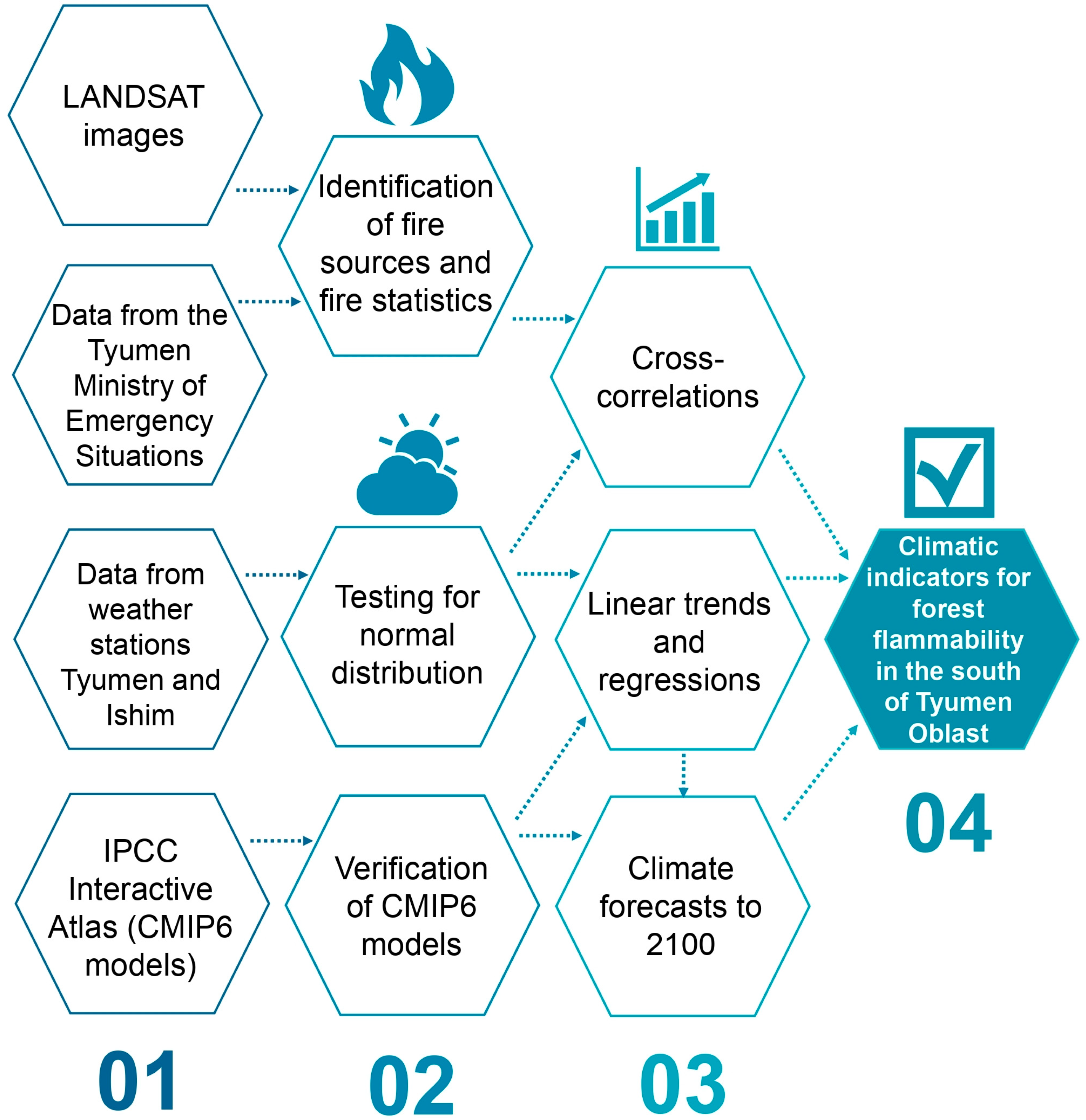


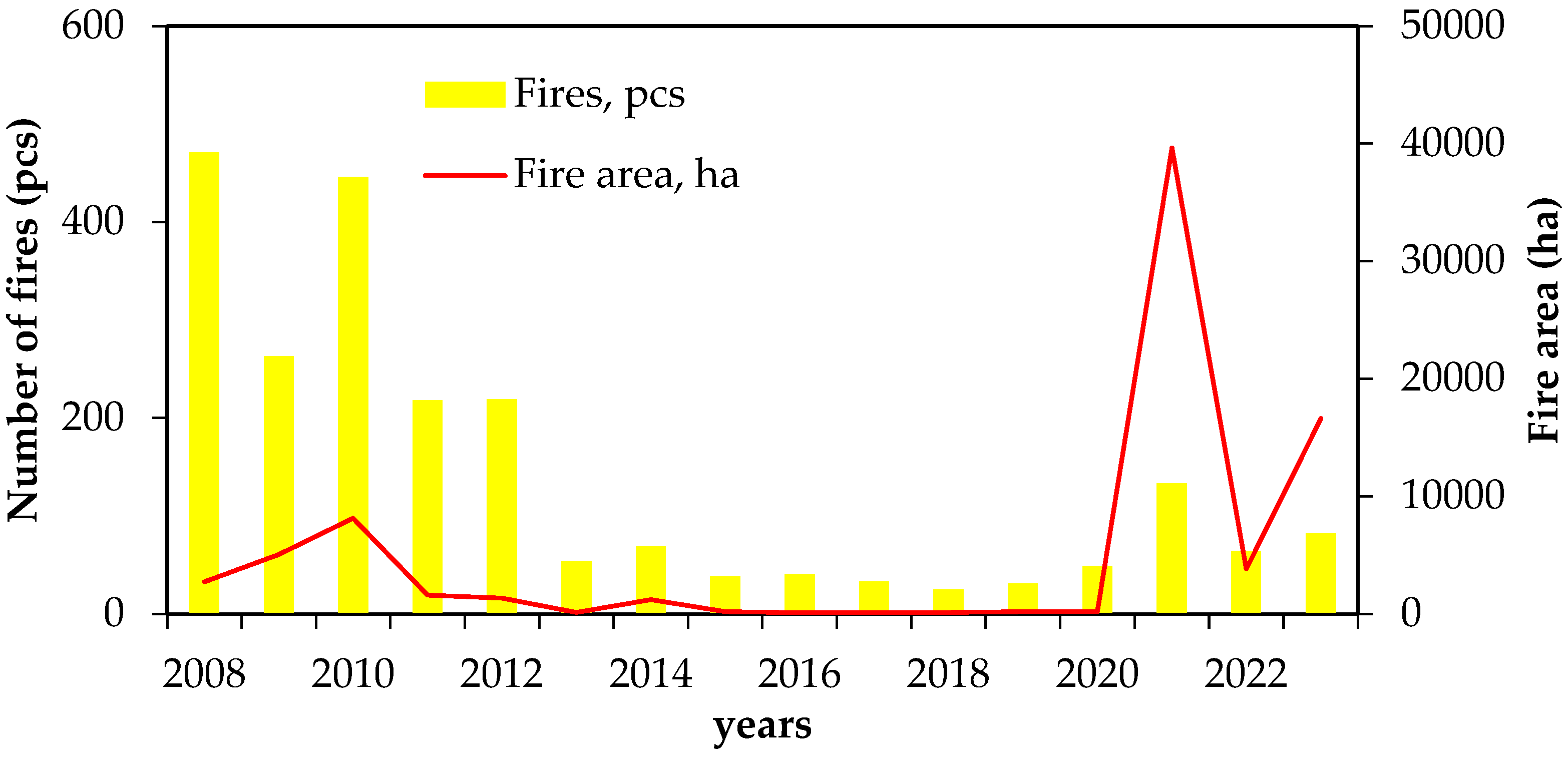
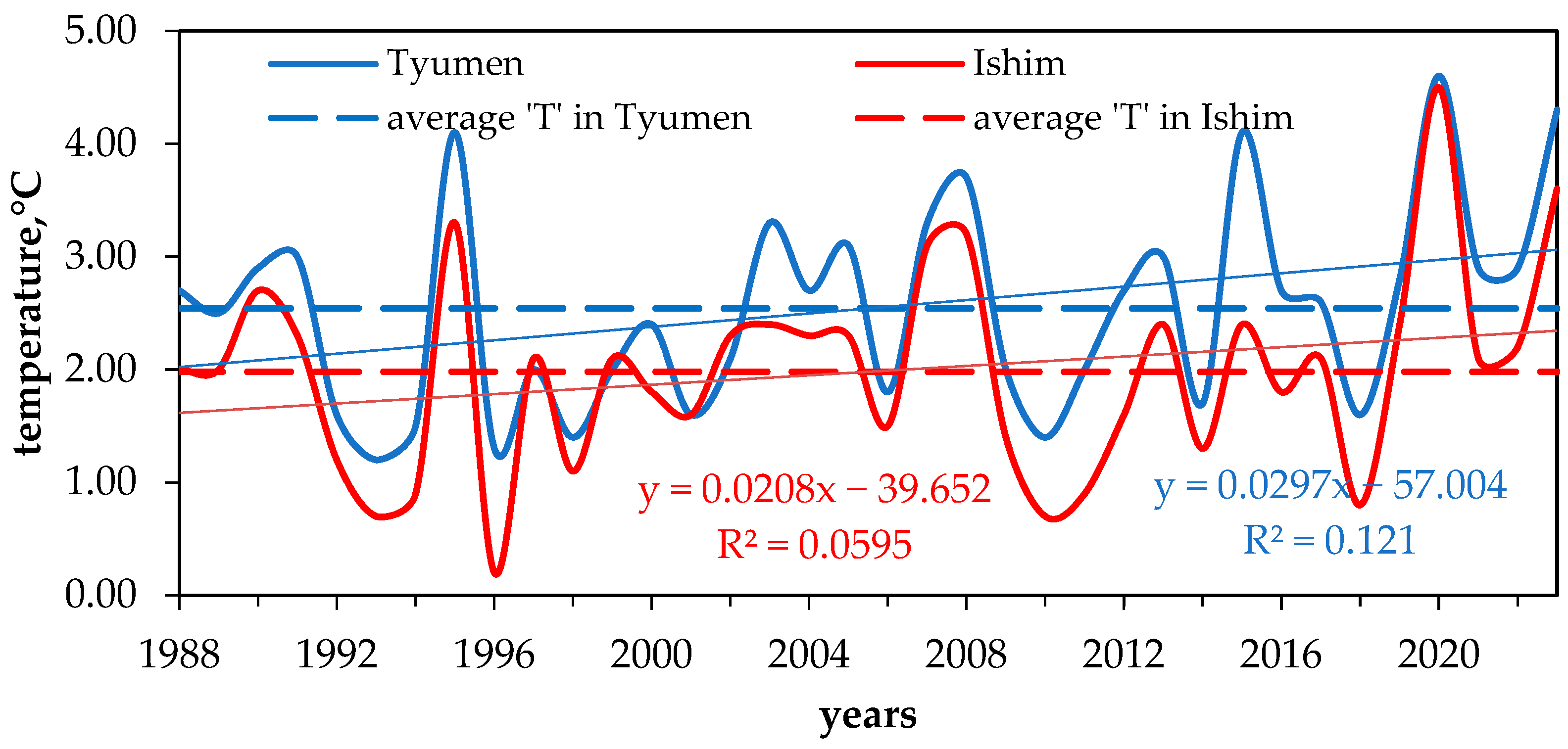


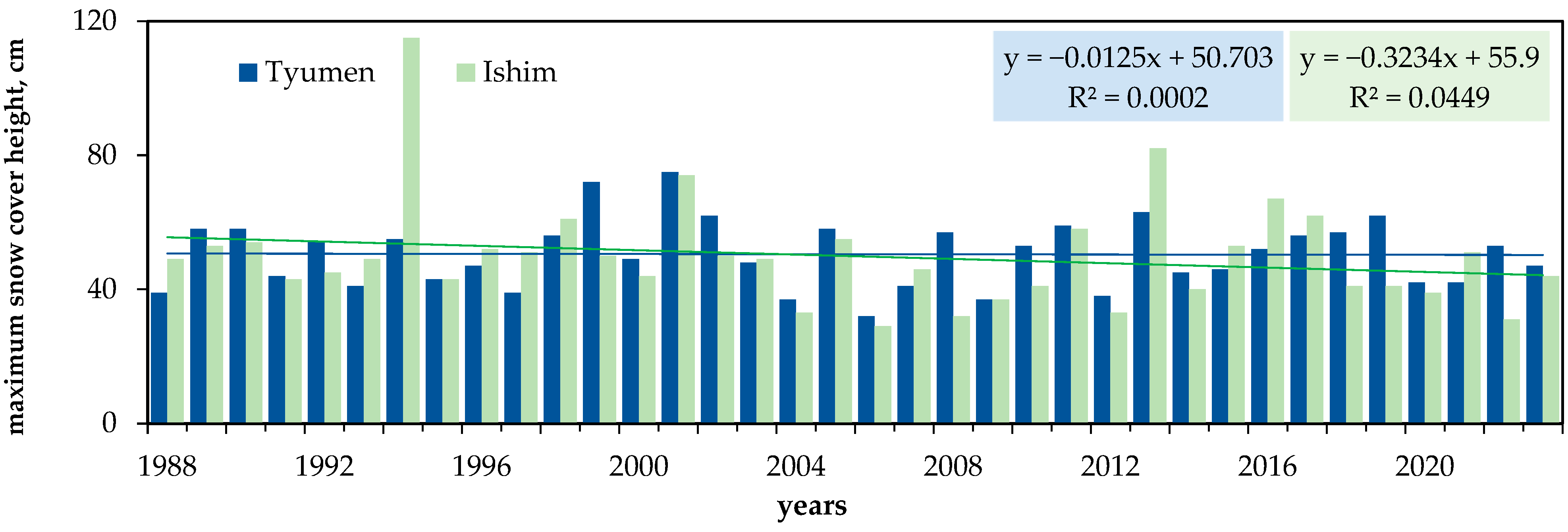
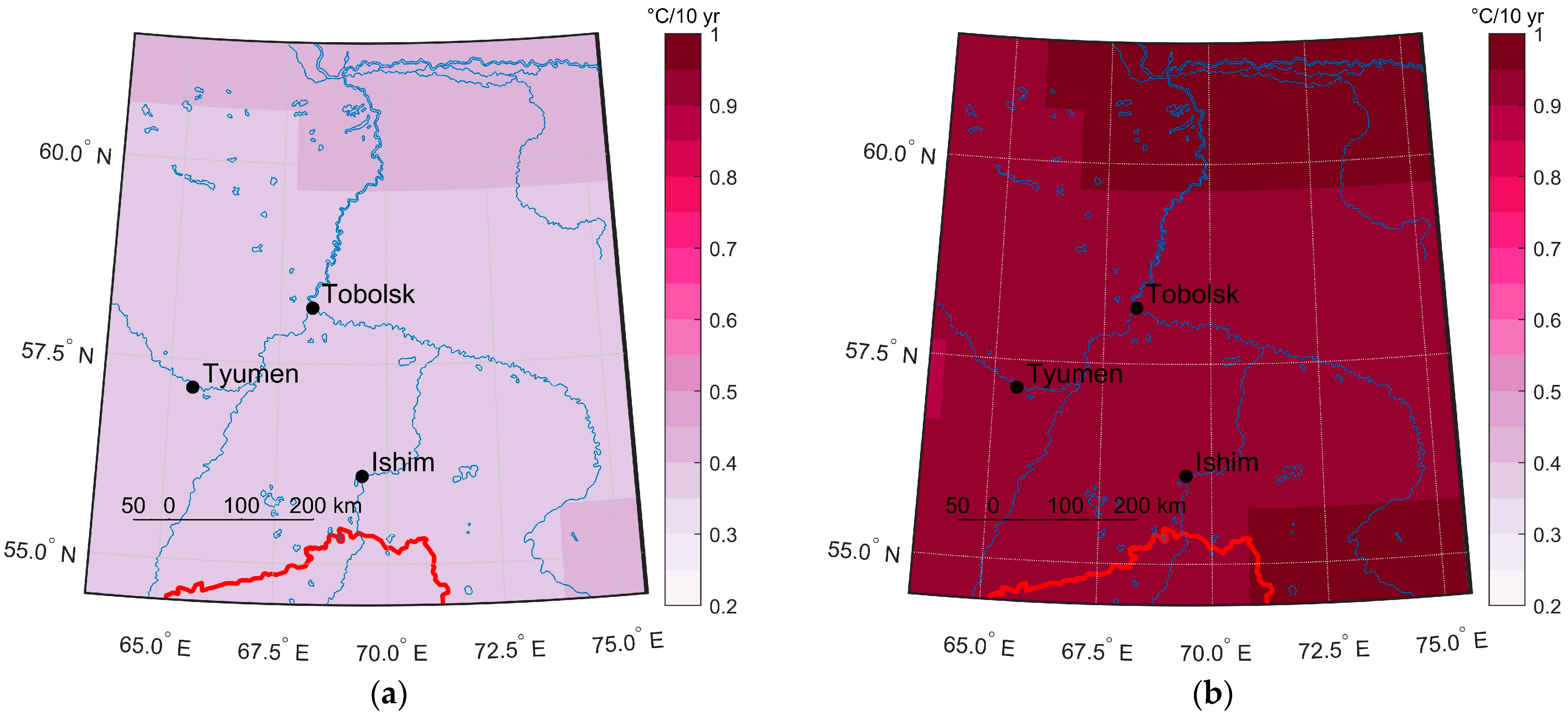
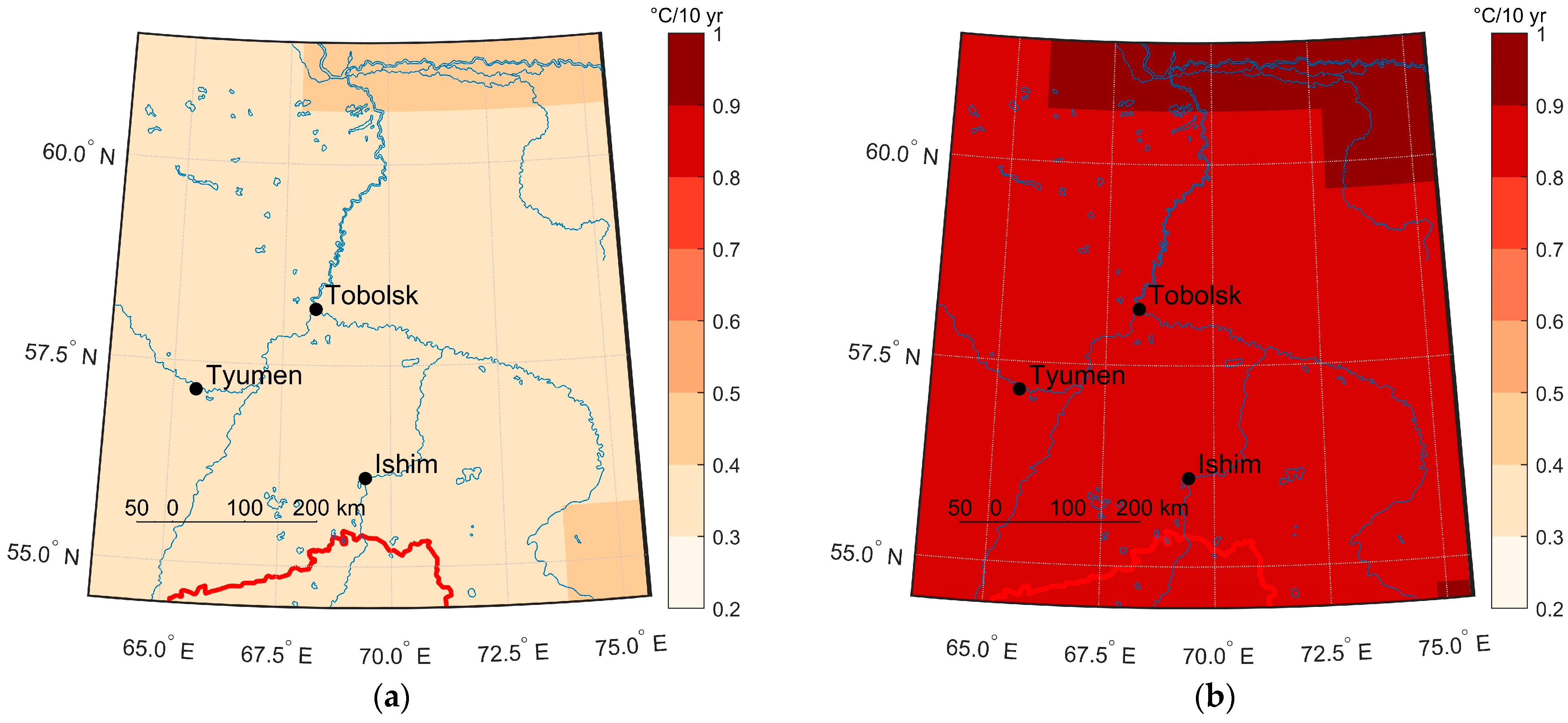
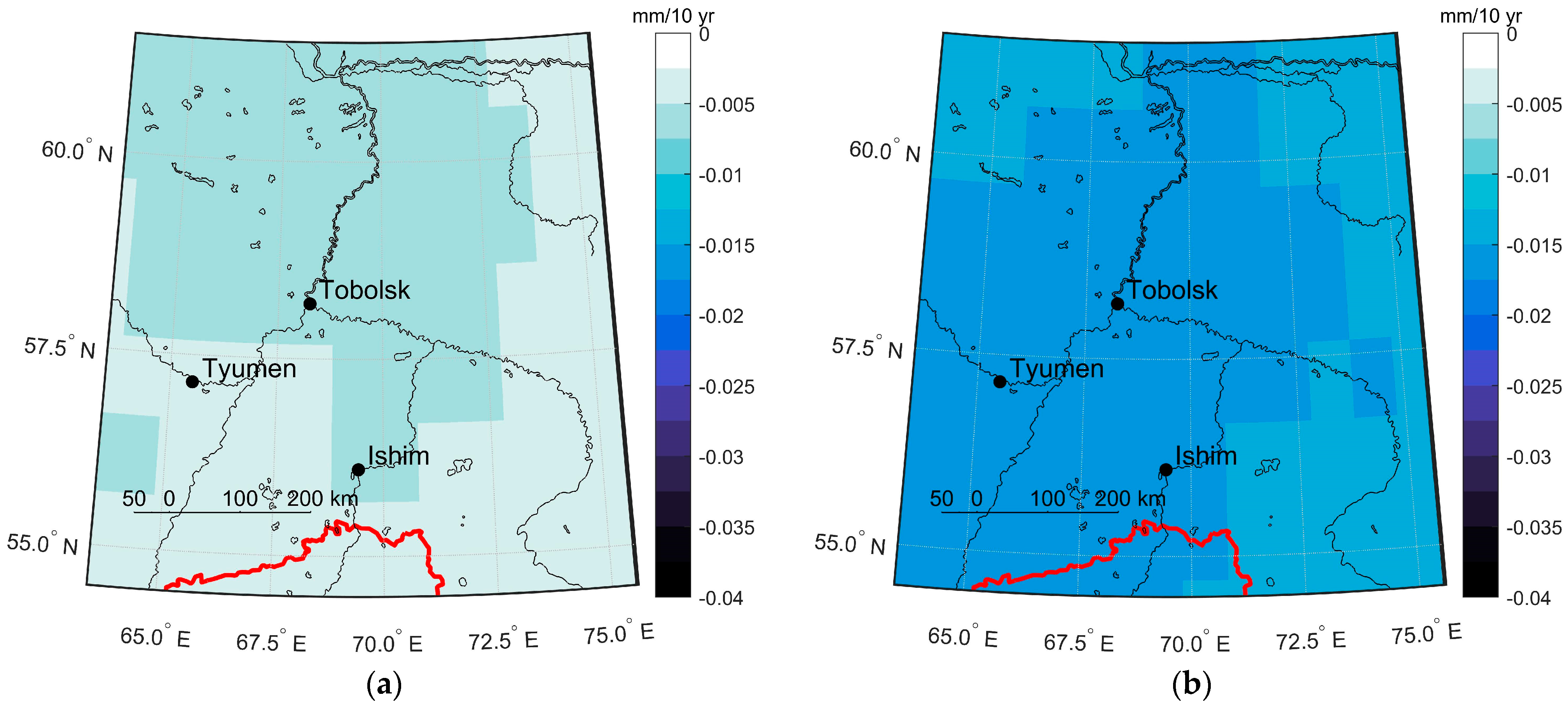
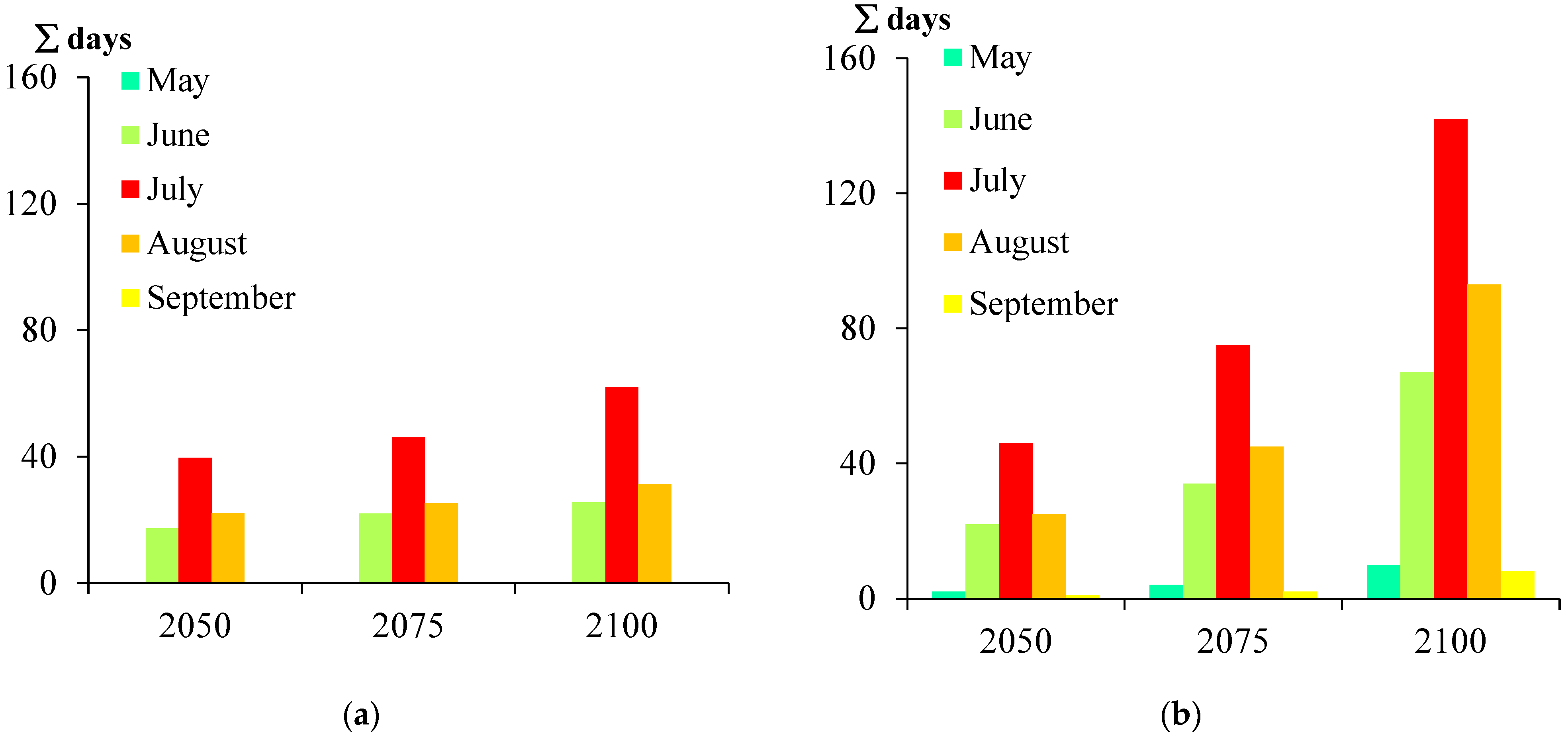
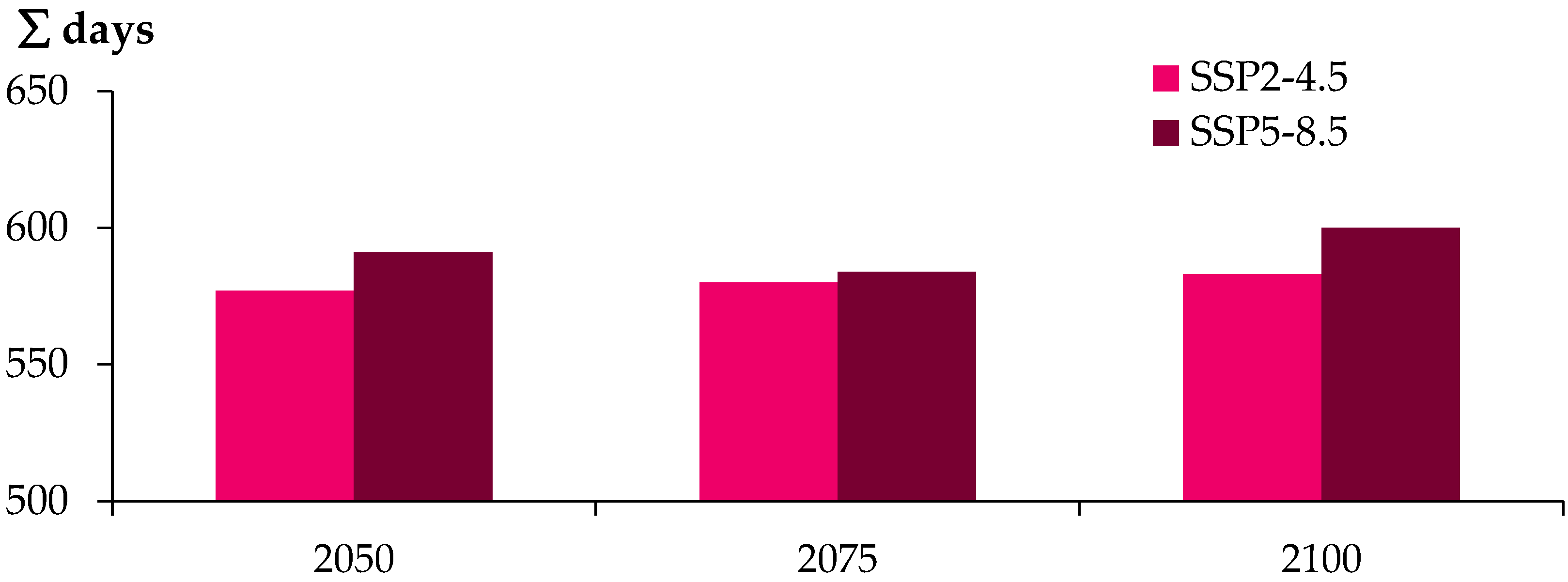
| Satellite Images | Spectral Channel | Wavelengths, mkm | Resolution, m/pix. |
|---|---|---|---|
| Landsat-5/TM | Band 1—Blue | 0.450–0.520 | 30 |
| Band 2—Green | 0.520–0.600 | 30 | |
| Band 3—Red | 0.630–0.690 | 30 | |
| Band 4—Near-Infrared (NIR) | 0.760–090 | 30 | |
| Band 5—Shortwave Infrared (SWIR-1) | 1.550–1.750 | 30 | |
| Band 6—Thermal | 10.40–12.50 | 120*(30) | |
| Band 7—Shortwave Infrared (SWIR-2) | 2.080–2.350 | 30 | |
| Landsat-8/OLI | Band 1—Coastal/Aerosol, New Deep (Blue) | 0.433–0.453 | 30 |
| Band 2—Blue | 0.450–0.515 | 30 | |
| Band 3—Green | 0.525–0.600 | 30 | |
| Band 4—Red | 0.630–0.680 | 30 | |
| Band 5—Near-Infrared (NIR) | 0.845–0.885 | 30 | |
| Band 6—Shortwave Infrared (SWIR 1) | 1.560–1.660 | 30 | |
| Band 7—Shortwave Infrared (SWIR 2) | 2.100–2.300 | 30 | |
| Band 8—Panchromatic (PAN) | 0.500–0.680 | 30 | |
| Band 9—Cirrus | 1.360–1.390 | 30 | |
| Ranges TIRS (Thermal Infrared Sensor) | |||
| Band 10—Thermal Infrared (TIR1) | 10.30–11.30 | 100 | |
| Indicators | Years | ||||
|---|---|---|---|---|---|
| 2019 | 2020 | 2021 | 2022 | 2023 | |
| The beginning of the fire-hazardous period | 23 April | 21 April | 20 April | 12 April | 3 April |
| The end of the fire-hazardous period | 25 October | 22 October | 26 October | 10 November | 27 October |
| Total number of days of the fire-hazardous period | 186 | 198 | 203 | 213 | 208 |
| Without Shift | With One-Year Shift | |||
|---|---|---|---|---|
| Number of Fires | Fire Area (ha) | Number of Fires | Fire Area (ha) | |
| T mean (°C) | −0.22 | 0.09 | −0.14 | 0.56 * |
| T mean max (°C) | 0.01 | 0.19 | 0.05 | 0.50 * |
| T abs max (°C) | 0.06 | 0.72 * | 0.03 | 0.22 |
| T fire hazard period (°C) | 0.17 | 0.49 * | 0.01 | 0.36 |
| V mean (m/s) | −0.39 | 0.00 | −0.20 | −0.02 |
| f mean (%) | 0.02 | −0.82 * | 0.21 | −0.05 |
| P (mm) | 0.03 | −0.62 * | −0.16 | −0.09 |
| max h snow (cm) | −0.07 | −0.34 | −0.22 | −0.37 |
Disclaimer/Publisher’s Note: The statements, opinions and data contained in all publications are solely those of the individual author(s) and contributor(s) and not of MDPI and/or the editor(s). MDPI and/or the editor(s) disclaim responsibility for any injury to people or property resulting from any ideas, methods, instructions or products referred to in the content. |
© 2024 by the authors. Licensee MDPI, Basel, Switzerland. This article is an open access article distributed under the terms and conditions of the Creative Commons Attribution (CC BY) license (https://creativecommons.org/licenses/by/4.0/).
Share and Cite
Kuznetsova, E.; Marchukova, O.; Kuznetsova, V.; Pigaryova, A.; Zherebyateva, N.; Moskvina, N. Climatic Indicators and Their Variation Trends as Conditions for Forest Flammability Hazard in the South of Tyumen Oblast. Fire 2024, 7, 466. https://doi.org/10.3390/fire7120466
Kuznetsova E, Marchukova O, Kuznetsova V, Pigaryova A, Zherebyateva N, Moskvina N. Climatic Indicators and Their Variation Trends as Conditions for Forest Flammability Hazard in the South of Tyumen Oblast. Fire. 2024; 7(12):466. https://doi.org/10.3390/fire7120466
Chicago/Turabian StyleKuznetsova, Elza, Olesia Marchukova, Vera Kuznetsova, Alyona Pigaryova, Natalia Zherebyateva, and Natalia Moskvina. 2024. "Climatic Indicators and Their Variation Trends as Conditions for Forest Flammability Hazard in the South of Tyumen Oblast" Fire 7, no. 12: 466. https://doi.org/10.3390/fire7120466
APA StyleKuznetsova, E., Marchukova, O., Kuznetsova, V., Pigaryova, A., Zherebyateva, N., & Moskvina, N. (2024). Climatic Indicators and Their Variation Trends as Conditions for Forest Flammability Hazard in the South of Tyumen Oblast. Fire, 7(12), 466. https://doi.org/10.3390/fire7120466







